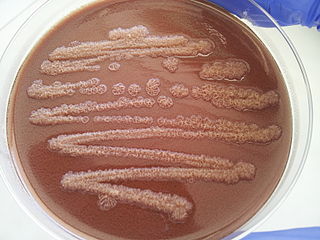Pseudomonas pachastrellae is a Gram-negative bacterium found in deep-sea sponges. The type strain is JCM 12285.
Pseudomonas argentinensis is a yellow-pigmented, Gram-negative, rod-shaped, non-spore-forming, strictly aerobic organism bacterium that infects the rhizospheres of Chloris ciliata and Pappophorum caespitosum, both grasses native to the Chaco region (Cordoba) of Argentina.
Pseudomonas moraviensis is a Gram-negative soil bacterium. It is named after Moravia, the region of the Czech Republic where it was first isolated. The type strain is CCM 7280T.
Pseudomonas simiae is a Gram-negative, catalase- and oxidase-positive, rod-shaped bacterium isolated from monkeys. The type strain is CCUG 50988.
Pseudomonas grimontii is a Gram-negative, rod-shaped, fluorescent, motile bacterium isolated from natural springs in France. The type strain is CIP 106645.
Pseudomonas trivialis is a fluorescent, Gram-negative bacterium isolated from the phyllosphere of grasses. The type strain is DSM 14937.
Pseudomonas poae is a fluorescent, Gram-negative bacterium isolated from the phyllosphere of grasses. The type strain is DSM 14936.
Pseudomonas congelans is a fluorescent, Gram-negative bacterium isolated from the phyllosphere of grasses. The type strain is DSM 14939.
Pseudomonas synxantha is a fluorescent rhizosphere bacterium with nematicidal properties. Based on 16S rRNA analysis, P. synxantha has been placed in the P. fluorescens group.
Pseudomonas knackmussii is a Gram-negative, polarly flagellated, motile, short rod bacterium isolated from a sewage treatment plant in Göttingen, Germany. It is the first bacterium used to study the degradation of haloaromatic compounds. It is named after Hans-Joachim Knackmuss. The type strain is DSM 6978.
Pseudomonas mediterranea is a bacterium, similar to P. corrugata, that causes tomato pith necrosis. For the phylogenetic analysis of P. corrugata and its closely related phytopathogenic bacterium Pseudomonas mediterranea refer to Trantas et al. 2015.
Pseudomonas kilonensis is a Gram-negative soil bacterium isolated from agricultural soil in Germany. The type strain is DSM 13647.
Pseudomonas pohangensis is a Gram-negative, non-fluorescent, non-sporulating, non-motile, rod-shaped bacterium isolated from seashore sand on Homi cape, near Pohang city, Korea. The type strain is KACC 11517.
Pseudomonas azotifigens is a Gram-negative, nitrogen-fixing bacterium isolated from a compost pile in Japan.

Pseudomonas stutzeri is a Gram-negative soil bacterium that is motile, has a single polar flagellum, and is classified as bacillus, or rod-shaped. While this bacterium was first isolated from human spinal fluid, it has since been found in many different environments due to its various characteristics and metabolic capabilities. P. stutzeri is an opportunistic pathogen in clinical settings, although infections are rare. Based on 16S rRNA analysis, this bacterium has been placed in the P. stutzeri group, to which it lends its name.
Pelomonas saccharophila is a Gram-negative soil bacterium. It was originally named Pseudomonas saccharophila in 1940, but was reclassified in 2005 to the newly created genus, Pelomonas. The original strain was isolated from mud.
Ideonella azotifigens is a nitrogen-fixing, Gram-negative, oxidase- and weak catalase-positive aerobic, motile bacterium from the genus Ideonella and family Comamonadaceae, which was isolated from grass rhizosphere soil in Ithaca in the United States.
Hansschlegelia beijingensis is a Gram-negative, aerobic and rod-shaped bacterium species from the genus of Hansschlegelia which has been isolated from rhizosphere soil from a watermelon plant in Beijing in the Daxing District in China.
Verrucosispora lutea is a Gram-positive, aerobic and spore-forming bacterium from the genus of Verrucosispora which has been isolated from mangrove sediments in the Guangdong Province in China.
Dyadobacter beijingensis is a bacterium from the genus of Dyadobacter which has been isolated from the rhizosphere from turf grasses from the Taoranting Park in Beijing in China.
